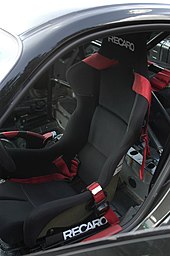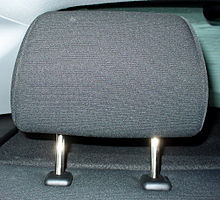Car seat
As a car seat in are automobiles built seats for the passengers as well as special child seat -Inserts for in-car use, respectively. Depending on the type of vehicle used and the distinction between driver and passenger seats as well as the level of equipment, the seats installed in automobiles can fundamentally differ greatly.
Car - driver seats / front seats
Most car models are equipped with a pair of individual seats at the front. Some models such as the Talbot Matra Murena or the Fiat Multipla have three seats in the front. The driver's seat is usually on the side that faces oncoming traffic, with the steering and control instruments opposite. Depending on the level of equipment, car front seats are more or less upholstered or have ergonomic shapes and headrests . In the case of higher equipment levels and especially in sports cars , the backrests can be curved to the side in order to absorb the lateral centrifugal forces acting on the upper body for better lateral support when cornering . For this reason, the standard seat of a passenger car is occasionally exchanged for a sports seat in order to improve lateral support when cornering and to reduce the weight of the vehicle.
adjustability
The scope and differentiation of the seat adjustment depends largely on the level of comfort and equipment. In most cases, the position of the two front car seats can be moved forwards and backwards on the seat rails in order to enable people of different heights to easily operate the pedals for gas, brakes and, if necessary, clutch . This is usually referred to as "linear seat adjustment" or 2-way adjustment. Very often the incline of the backrest can also be adjusted. Backrests that can be reclined very far are called reclining seats by some manufacturers. With more comfortable car seats, there are adjustments of the height, the lumbar support , and the seat inclination, seat heating and other comfort functions.
- A 4-way seat adjustment means the adjustability horizontally forwards and backwards as well as in the inclination of the backrest forwards and backwards.
- A 6-way seat adjustment includes not only the 4-way adjustment functions but also the height adjustment up and down.
The adjustment takes place in different ways, depending on the product, with locking pawls and manual adjustment, side handwheels , levers with pumping movements, hand cranks or via switches with electrical or electro-hydraulic support. The scope of the adjustment possibilities and the way in which the adjustment takes place are of particular importance in the context of adapting vehicles for physically handicapped people .
With electrical adjustment, several different seat settings can be saved electronically and activated to change ("memory"). Further information can also save and set individual driver-specific settings for headrests, steering columns and exterior mirrors (including automatic curb control). Time-consuming new settings when changing drivers can thus be avoided.
In two-door vehicles with four seats, the backrests of the front seats or, in individual cases, the entire seats can be folded forward to enable the passengers to reach the back seat.
Comfort equipment
Additional seat heating , seat air conditioning and ventilation can be provided for the driver's seat, and in some cases also for the front seat . Luxury vehicles may have screens in the rearward facing side of the front seat backrests to allow rear seat passengers to watch television, watch videos, etc. More comfortably equipped models have armrests .
Safety and health
Vehicle seats are important for safe driving. First of all, good ergonomic seats prevent physical strain and fatigue, so attention and concentration do not deteriorate so quickly; this also prevents accidents at all. For frequent and professional drivers, the seats protect the human musculoskeletal system from one-sided and thus pathogenic stress and from unhealthy sitting positions.
In modern vehicles, an airbag is integrated on the side of the backrest towards the body, which is intended to mitigate the side impact.
Car rear seats
The seats in the second row, also known as the back seat or rear seat, are adapted to the level of the front seats in terms of seat position, upholstery and shape. An ergonomic shape was usually less pronounced, as the number of people sitting there often varied. Only with the introduction of compulsory seat belts for the rear seat bench was the number of passengers effectively set to 3, in order to allow a total of 5 approved seats. Limited by the width of the vehicle and the space required by the rear axle, there are usually only two ergonomically shaped rear seats with an emergency seat in the middle. Only from the compact van class 3 shaped rear seats are common.
With a simple and inexpensive design, the seats in the second row are fixed and non-adjustable on a common mounting frame. In better equipped models, the backrest can be fully or partially folded down to enlarge the cargo space behind it. The cross-divisions that are most commonly used are:
- 1 / 2-1 / 2 also called 50/50,
- 1 / 3-2 / 3 also called 60/40,
- 40-20-40
Depending on the model, after folding down the backrest, it is also possible to fold the entire seat into the footwell in order to obtain a very large flat loading area.
Child seats
See main article child seat
Bus and minibus / van passenger seats
With a simple and inexpensive design, passenger seats are fixed and non-adjustable mounted on a common frame as a double or triple bench. In better equipped vehicles, there are individual seat shells on the frame; complete, side-by-side single seats, each with their own backrest adjustment, are even more comfortable. These are very similar to the seats in modern trains and airplanes . Partly there are also widely adjustable reclining seats.
In small trucks and vans like the VW bus , the rear seats could and can often be removed in order to also increase the variability between passenger and goods transport.
The concept of the variably adjustable and foldable row of single rear seats was transferred by Opel with the Opel Zafira to the basis of a compact class car , creating a new vehicle class of compact vans. In addition to the 3 ergonomically designed individual seats in the first row of rear seats, a second rear bench with reduced space is usually available as standard or as an accessory. With 5 full and 2 limited seats, this enables high economic efficiency.
Driver seats / front seats of trucks, buses and work vehicles
Most truck models have a pair of single seats at the front, particularly large trucks can have three seats in the front and work vehicles can have rear bench seats. Buses usually only have one driver's seat at the front in the same place as a car. In the case of special work vehicles, the driver's seat can also be on the opposite side, for example in street cleaning vehicles , in order to improve the overview of the roadside.
Compared to typical car seats, truck and bus seats are designed for a significantly higher seat position and a more upright posture . This seems to be primarily a result of the larger available space in the driver's cab . Adjustment options, upholstery, shape and comfort features are just as different as with cars and depend on the level of equipment. When adjusting, pronounced reclining positions and usually also folding forwards are dispensed with.
Car seat manufacturer

Car seats are usually not produced by the car manufacturers themselves, but obtained from suppliers. In the early days of automobile construction, saddleries were mostly commissioned. The large German car seat manufacturer Recaro also emerged from a saddlery. Even today one speaks of car upholstery when one would like to designate the department for the production of car seats at full-range manufacturers like the BMW subsidiary Rolls-Royce . Seat production is a classic example of just-in-sequence production in the modern automotive industry, because the large variety of types (e.g. Audi Q5: approx. 2000 different variants of seat sets per vehicle can be ordered by the customer, English mass customization ) Stockpiling production is no longer possible.
Major manufacturers are:
- Germany: Recaro and C. Rob. Hammerstein , both under the umbrella of Adient, Magna Seating , Sitech , Isringhausen , Greiner GmbH, König Komfort- und Rennsitze GmbH, Brose Fahrzeugteile
- France: Faurecia
- Italy: Sparco, OMPracing, Sabelt
- USA: Lear Corporation , Adient (formerly the automotive division of Johnson Controls )
See also
literature
- Hans-Hermann Braess, Ulrich Seiffert: Vieweg manual automotive technology. 2nd Edition. Vieweg, Braunschweig 2001, ISBN 3-528-13114-4 .





